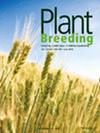植物开花和种子发育的表观遗传调控研究进展
IF 1.5
4区 农林科学
Q2 AGRONOMY
引用次数: 0
摘要
生长在不同纬度的植物感知和解释昼长(光周期)和暴露于寒冷冬季温度(春化)的季节变化。这些因子控制着与开花有关的各种基因的表达,这取决于光周期和春化的变化。植物的表观遗传调控系统已经进化到可以处理环境信号。一年生植物和多年生植物的基因表达都是通过染色质重塑和小rna来响应季节变化的。开花的关键调控因子,如开花位点C (FLC)和开花位点T (FT),与其他开花调控因子相互作用,并根据季节线索进行染色质重塑。多梳抑制复合体(Polycomb repression complex, PRC)在光周期开花调控中控制着开花相关基因的表达。FLC作为一种有效的抑制因子,通过下调促进开花的基因的表达。甲基化,特别是在CHG, CG和CHH的背景下,在胚胎发生中起着关键作用。这篇综述简要地探讨和描述了植物开花机制对日长变化、冷暴露(春化)和种子发育的响应。本文章由计算机程序翻译,如有差异,请以英文原文为准。
Epigenetic‐based control of flowering and seed development in plants: A review
Abstract Plants grown at different latitudes perceive and interpret seasonal variations in day length (photoperiod) and exposure to cold winter temperatures (vernalization). These factors control the expression of various genes involved in flowering, depending on the variations in photoperiod and vernalization. Epigenetic regulatory systems have evolved in plants to process environmental signals. Gene expression is modified through chromatin remodelling and small RNAs in response to seasonal changes in both annual and perennial plants. Key regulators of flowering, such as FLOWERING LOCUS C (FLC) and FLOWERING LOCUS T (FT), interact with other floral regulatory factors and undergo chromatin remodelling in response to seasonal cues. The Polycomb repressive complex (PRC) controls the expression of flowering‐related genes in photoperiodic flowering regulation. FLC acts as a potent suppressor by down‐regulating the expression of genes that promote flowering. Methylation, particularly in the context of CHG, CG and CHH, plays a critical role in embryogenesis. This review briefly explores and describes the regulation of flowering mechanisms in response to day‐length variations, cold exposure (vernalization) and seed development in plants.
求助全文
通过发布文献求助,成功后即可免费获取论文全文。
去求助
来源期刊

Plant Breeding
农林科学-农艺学
CiteScore
4.40
自引率
5.00%
发文量
74
审稿时长
3.0 months
期刊介绍:
PLANT BREEDING publishes full-length original manuscripts and review articles on all aspects of plant improvement, breeding methodologies, and genetics to include qualitative and quantitative inheritance and genomics of major crop species. PLANT BREEDING provides readers with cutting-edge information on use of molecular techniques and genomics as they relate to improving gain from selection. Since its subject matter embraces all aspects of crop improvement, its content is sought after by both industry and academia. Fields of interest: Genetics of cultivated plants as well as research in practical plant breeding.
 求助内容:
求助内容: 应助结果提醒方式:
应助结果提醒方式:


